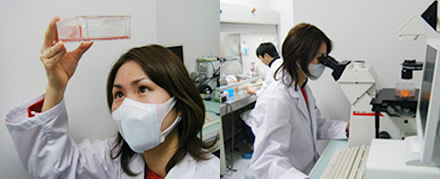Research
We at the Department of Ophthalmology, Kyoto Prefectural University of Medicine
run the “Department of Ophthalmology” undergraduate programs, and the “Ocular Function Surgical Regeneration Department” for graduate programs and clinical research.
The name reflects our concept that new methods of treatment can restore vision for those who have lost theirs, and that we hope for those methods to be regenerative in nature if possible.
Our department is split into five subdivisions for groups in treatment and research. These groups focus on the cornea, glaucoma, the vitreous, ocular function, and reconstructive surgery.
Each of these groups tries to ‘be international’, and aims to carry out world-class, cutting-edge translational research. Our varied research content spans from the most basic content to highly advanced clinical research.
The cornea is our area of expertise, and we are especially proud of our world-class, cutting-edge research about the ocular surface.
The cornea group research includes (regeneration) using corneal epithelium stem cells and a cultured corneal epithelial sheet, research into new diagnostics and treatments for dry eye, healing injuries to the cornea, surface bacterial flora and MRSA, corneal transplants and more.
The glaucoma group analyzes glaucoma over the long term, developing new ways to measure intraocular pressure, and researching targeted treatments for steroid glaucoma.
The retina and vitreous group develops new ways to treat retinal vascular occlusion, vitreoretinal surgery to treat uveitis, investigates macular edema and macular degeneration, and more.
The ocular function group conducts wavefront analytical research related to LASIK surgery and clarifies how myopia develops, in order to develop better surgical methods, while the reconstructive surgery group investigates new methods of surgical treatment for periocular tumors and surface trauma.
As a clinical department, our research instruments naturally include cell cultures and ordinary PCR, while we also have laser micro-capture, a capillary sequencer, real-time PCR, and a filter-free laser confocal microscope, which we employ to research the latest molecular and cellular biological techniques.
Our groups feature a unified directional policy, while still respecting researchers’ individual freedom and diversity. Furthermore we always go forward while keeping in mind that ‘the results of our research must feed back into clinical practice’.
Speaking temporally, we believe that clinical practice offers present treatments, while research provides treatments in the future. Whether domestic or international, or research or corporate, we carry out many cooperative research projects. We welcome anyone with interest in our research to enquire further.
(Professor Emeritus, Shigeru Kinoshita shigeruk@koto.kpu-m.ac.jp)

